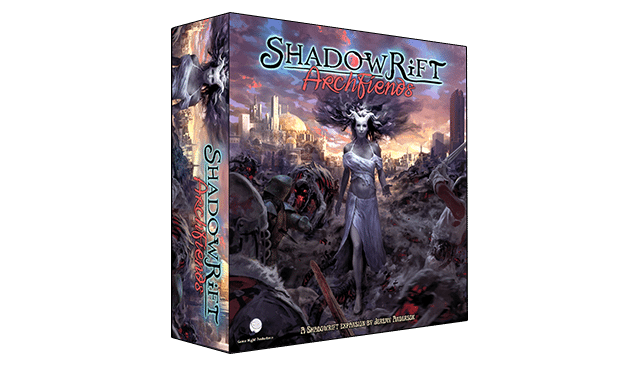Through the years, there have been many tabletop wargames and I have played a lot of them over the course of several decades. While they cover the gamut of battles and wars throughout history, it seems a plurality of them focus on World War II. Even within the WWII genre, the variety is impressive. There are games that cover the entire war at a strategic level, those that cover entire battles at the operational level, and even some that delve down to the tactical level of individual squads of soldiers, tanks, and support weapons. The difficulty of the games even vary from easy-to-follow rules that beginners can play to intense rulebooks, some of which even come in three-ring binders. Then at the tactical level, some games use cardboard counters while others use cards or have miniatures for the units. A recent release, Company of Heroes Board Game, finds a great balance between detail and accessibility, depicts tactical combat while including resources, and even comes with beautiful miniatures.
What Is Company of Heroes Board Game?
Company of Heroes Board Game is a tactical combat tabletop game set in the European Theatre of World War II for 2-4 players, ages 12 and up, and takes about 60-120 minutes to play. The game is based on the popular Company of Heroes video game series and is the result of a successful Kickstarter campaign in June 2019. The games began to be delivered to supporters earlier this year and are now available to the general public through the game’s website with a price of $139.95 for a copy of the game for up to 4 players which includes all four factions. A 2-player version of the game with only the US and German factions is also available for $89. Terrain packs, a Solo-Co-op expansion, and unit expansions are also available for purchase. Company of Heroes Board Game was published by Bad Crow Games and officially licensed by SEGA and Relic Entertainment.
Company of Heroes Board Game Components
Here is what you get in the box:
- 116 Infantry miniatures
- 30 Mortars, AT-guns, and machine guns (10 of each type)
- 50 tank and vehicle miniatures
- 4 Double-sided map panels
- 4 HQ boards
- 12 Building boards
- 21 Commander cards
- 54 Damage, status, and unit dice
- 12 Pip dice
- 120 White and orange cubes
- 36 Command point cubes
- 8 Emplacement and Bunker tokens
- 12 Field defense tokens
- 4 Base tokens
- 32 Flag and resource tokens
- 26 Infantry trays
- 6 Vehicle trays
- 2 Sand timers
- Basic Rulebook
- Advanced Rulebook
- Mission Book

Each faction has their own set of miniatures which include 24 infantry figures, light vehicles, and heavy vehicles. All factions, with the exception of the Soviets, also have 6 anti-tank figures, and the US faction includes 2 major figures to represent officers. The miniatures for each faction come in their own tray which keeps them nice and organized. There are also weapons miniatures shared by all factions to represent infantry weapon teams.


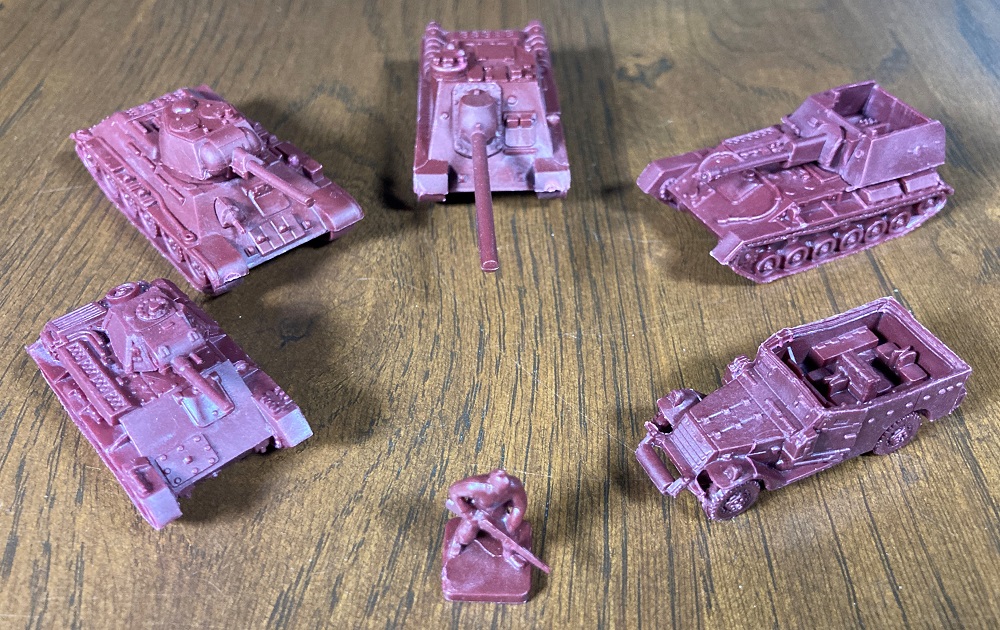

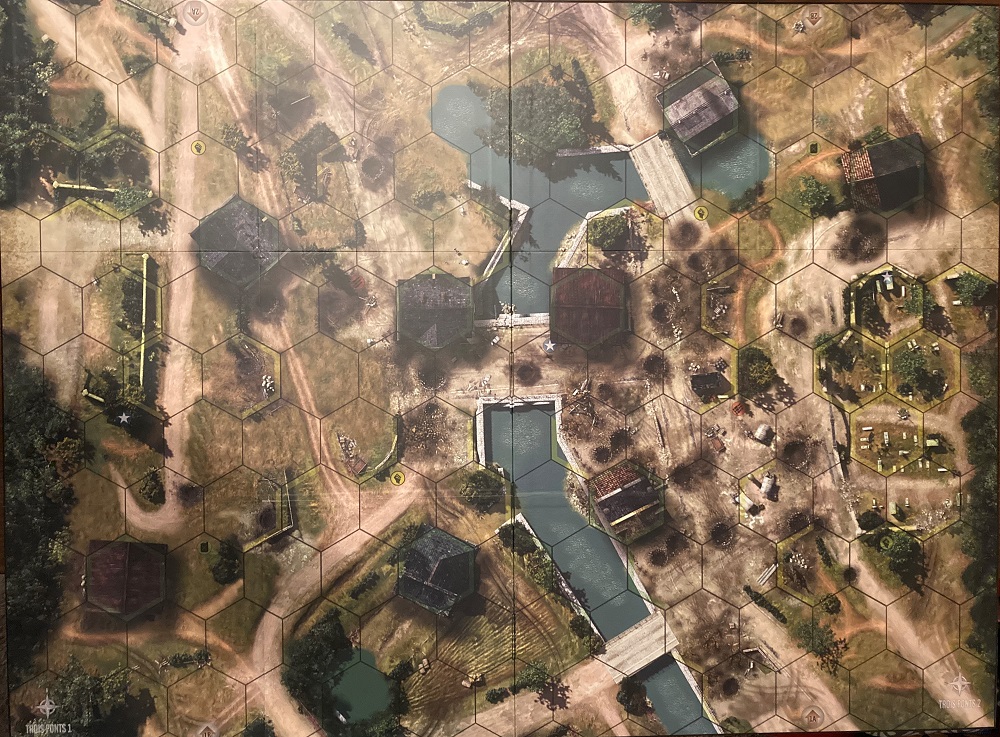
The main game includes four double-sided map panels which can be assembled to form four different 2-panel medium maps: Trois Points, Hill 331, Monastery, and Stalingrad. These maps are 27″ x 36″. The mission book also contains missions using only one map for smaller battles as well as some maps that use three, four, or even more map panels for large and huge games.

Each player receives a HQ board which uses white cubes to keep track of resources: manpower, fuel, munitions, and victory points. The top half of the board is for income while the lower half is for the stockpile of resources.
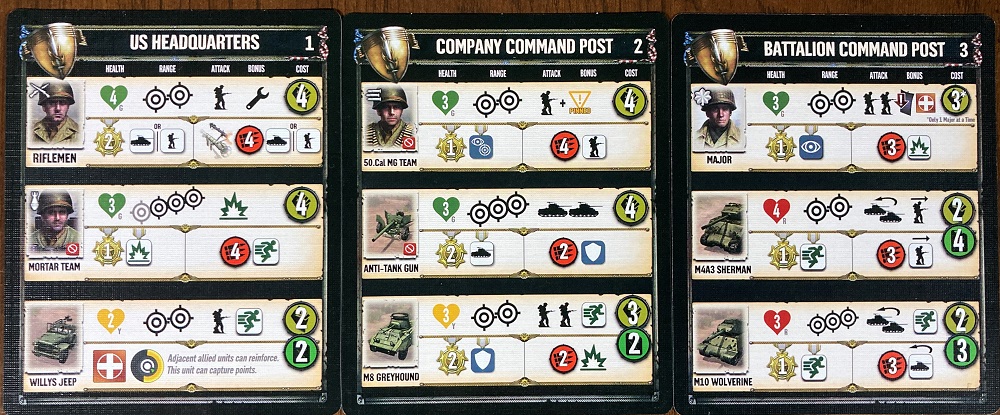
Building boards represent a faction’s ability to produce new units. Each faction has three building boards. However, only one is active a the start of the game. The other two are turned face down, but can be flipped over during the supply phase by spending the cost in resources listed on the back. Building boards have all the information about each type of unit including its cost, health, type of unit, range, attack types, and upgrades.
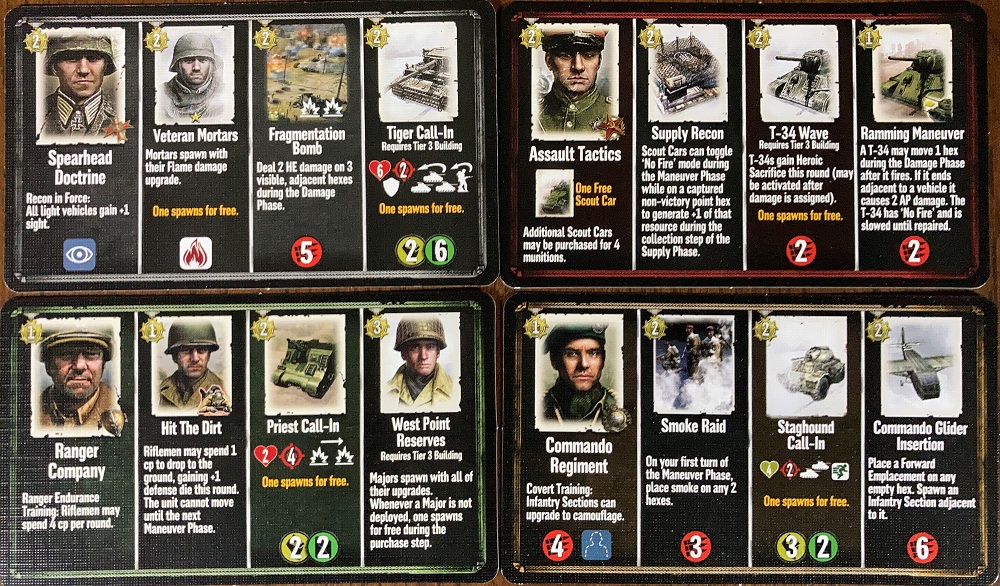
Each faction comes with five different commander cards. In addition, there is one that can be used by all factions. Commander cards allow players to customize their play experience by providing additional upgrade options, new units, and pay-per-use abilities. Players can choose any commander card from their faction at any time during the game. However, as soon as they purchase the first tier, they can no longer switch to a different commander. The commander card is placed in the upper right slot of the HQ board. A white dice is used to show which tiers have been unlocked. Tiers must be unlocked in order from left to right.

Dice are used for a number of tasks in Company of Heroes Board Game. The white damage dice are used to assign damage on a target, to show upgrades, and are rolled for defense. The red dice are status dice and placed on units to remind players of status effects. The blue dice are unit dice and used to show upgrades or special abilities for units. The white pip dice are used to show the health of buildings.

There are several different types of tokens in the game. Some are used to represent emplacements and bunkers that act like static units. Others represent field defenses such as sandbags, barbed wire, and tank traps. There are also tokens to represent resource locations and flags for controlling those locations. The game also includes a couple sand timers for use when playing the advanced timed rules.
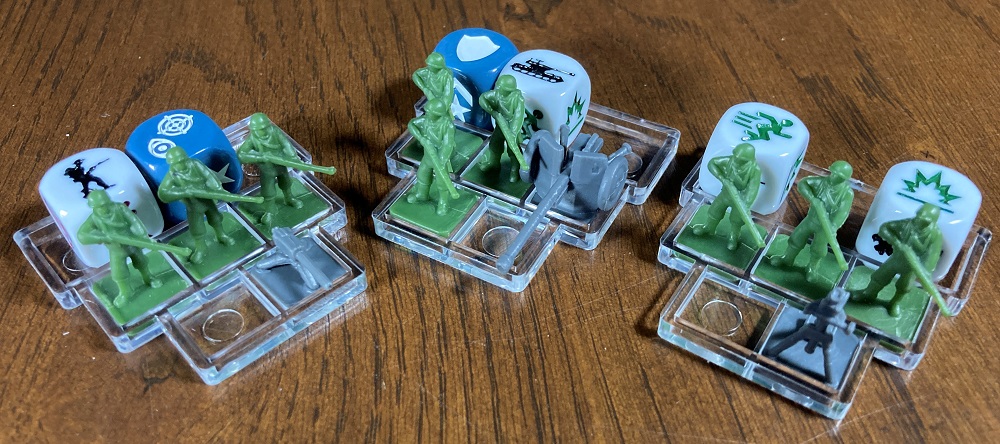
Infantry squads and weapons teams use infantry trays to keep the units organized. The infantry figures are placed on them to represent health and dice can be added to show status and upgrades. There are also vehicles trays which can be placed under a vehicle to keep damage cubes and status dice together with the vehicle miniature.
How to Play Company of Heroes Board Game
There are a number of different missions which can be played and are contained within the Mission Book. The following instructions are for a 2-player basic game played with the basic rules. You can download a copy of the rulebook here.
The Goal
The goal of the game is to gain the required amount of victory points at the end of the Supply Phase. You can earn victory points by destroying enemy units and controlling victory point hexes.
Setup
Start off by placing the map boards for the mission in the center of the playing area with all dice, cubes, and markers within reach of all players. Each player then takes an HQ board with 8 white cubes, the three building boards for their selected faction, 9 command point cubes of one color, and a tray of their faction’s miniatures along with six infantry trays. On the HQ board, place white cubes in the 1 space for income for manpower, fuel, and munitions and in the star or 0 slot for victory points. In the stockpiles section, place a white cube in star space for victory points and the rest in the 4 slot for the the starting stockpile of resources. These can vary depending on the mission. Turn over the second and third tier building boards so they are face down. You can pay to unlock these building boards during the game. Determine the length of the game by choosing a victory point condition. For short games, play to 13 victory points. For medium or long games, play to 15 or 18 points respectively.
Now each player chooses their starting units. Look at the tier 1 building board and select 2 infantry squads. These are the units with the green health symbol. Each faction as two of these squads from which to choose. For example, the US player can choose Riflemen or Mortar teams while the German player can choose Grenadiers or MG42 teams. You can pick two of one type of unit or one of each. When spawning an infantry squad, take an infantry tray and place one infantry figure in the tray for each health point. For weapon teams, place the infantry figures and then add either a machine gun, mortar or anti-tank gun miniature. The weapon mini does not represent a health point. Finally, place the units in your team’s spawn area. This is usually the back row of one of the map panels on the player’s side. Once all players have deployed their starting units, you are ready to begin play.

Gameplay
In Company of Heroes Board Game, gameplay is divided into rounds, with each round consisting of three phases. At the start of a round, players determine who goes first. The player with the fewest collected victory points determines if they want to go first or last for the round.
Maneuver Phase
The maneuver phase is divided into 3 turns. During each turn, a player may spend 3 command points (cp). They can spend all three cp on one unit or divide it among 2 or 3 units. Any unspent cp are forfeit. After the first player spends their 3 cp, then the second player spends 3 cp. This continues with players alternating turns. Each cp can be spent to move one unit one hex. However, units cannot move through hexes with water, through red impassable terrain lines, or through enemy units. Only regular infantry units and machine gun teams can move into building hexes designated by green heavy cover hex lines and an image of a building. To move a unit, place a cp cube in the hex to which you want to move the unit, and then move the unit into the hex. Keep all cp with the unit to keep track of how much that unit has moved during the round. A unit can only spend 3 cp during the round. Therefore, for the first round when each player has only two units, they can only spend up to 6cp. Some light vehicle units, with the yellow health value, have a speed upgrade which allows them to move an extra hex one time per round. This does not count as a cp, so one of these units could actually move 4 hexes during one turn. After all players have spent or forfeited their 9 cp, remove the cp cubes from the map and move to the damage phase.

Damage Phase
At the start of the damage phase, each machine gun team can pin one enemy unit within their sight range and firing range. Place a pinned die on the enemy unit. Pinned units cannot deal damage, capture control points, spend cp, move, or use their abilities. They still receive defense dice, reinforcement, and can be used to spot for other units. Machine gun teams cannot be pinned themselves. Each unit has a default sight range of 2 hexes. Some can see farther. Allied units can spot for their side. This means that if a unit is within sight range of an enemy, all other units can see that enemy unit. Every unit also has a firing range listed on the building boards. Buildings block sight if a line drawn from the center of the attacking unit’s hex to the center of the target hex crosses a building hex. The line of sight passing along a hex side of a building is not blocked.
The first player assigns damage first. To do this, they announce the attacking unit and place that units damage dice onto their target that is within both sight and firing range. There are four different types of damage: anti-infantry, armor piercing, high explosive, and flame. Regular infantry and machine gun teams inflict anti-infantry damage, so they would place a damage die with the soldier face up next to the target while a mortar team would place a damage die with the explosion symbol on it face up to represent high explosive damage. A machine gun which is pinning a unit must attack that same unit.
After damage has been assigned, the defender may be able to roll defense dice. Infantry and weapon teams roll one defense die for each armor piercing damage dice they receive, light vehicles can roll defense die for anti-infantry and high explosive damage dice, and heavy vehicles roll get defense dice for high explosive damage dice on them. Heavy vehicles are immune to damage from either anti-infantry or flame attacks. For each defense die, roll a damage dice. Units inside a building also get 2 additional defense dice. This does not apply to flame damage. Any green or black symbol rolled blocks one damage. Any red results are fails. As an example, a US rifleman unit attacks a German Kubelwagen, a light vehicle. The riflemen apply an anti-infantry damage die to the Kubelwagen. The German play may then roll one defense die to try to block that damage.
After defense dice have been rolled, inflict the damage. For each point of damage, remove an infantry figure from infantry and weapon team units. For vehicles, place an orange cube next to it. Once a unit has no more health remaining it is destroyed. Since damage during the damage phase is considered simultaneous, wait until both players have attacked before removing destroyed units. When a player destroys an enemy unit, they gain a victory point. Increase the victory point stockpile by one. Once both players have completed the damage phase, continue to the supply phase.
Supply Phase
This phase is all about resources. In the game there are four types of resources: manpower, fuel, munitions, and victory points. Manpower and fuel are used to purchase units while munitions can be spent for upgrades and special abilities. Victory points are what you need to win the game. At the start of the supply phase you capture objectives. If you have an infantry squad, weapons team (both with green health icons) or a unit with the capture ability on a control point, place a flag token of your color on that point. If there is a flag of your opponent’s color on it, remove it as well. Now, for each control point you just captured, increase your income for that type of resource by one on your HQ board. Lower your income for any control points you lost by one for the matching resource. After adjusting your income, then collect your resources by increasing your stockpiles by the amount of your income for each resource.

Now that you have more resources, you can spend them. Each unit has a cost in manpower and/or fuel. Purchases can be make simultaneously or according to turn order depending on the choice of the players. To purchase a unit, look on the building boards to see the cost. Lower the stockpiles for the corresponding resources and then place the new unit within your spawn area. Most units have a couple upgrades. The munitions upgrade can be purchased using munitions from your stockpile. These often give the unit an additional attack. For the US riflemen, you can spend 4 munitions to gain either a second anti-infantry attack or an armor piercing attack. The represents giving the squad either a light machine gun or a bazooka. After you decide which upgrade you want, take a damage die and place it in the unit’s tray with the chosen attack face up to remind you that this unit had been upgraded. You can also purchase experience upgrades. Experience is gained when you successfully inflict damage on an enemy unit for the first time in a round. You also gain one experience for each unit you destroy. Place a white cube in the experience area of your HQ board for each experience point you gain. Spend these cubes as you use your experience points. It is important to note that you are upgrading a single unit and not all units of that type. You could pay the cost a second time to upgrade another unit. In addition to purchasing or upgrading units, you can also construct new buildings. This is accomplished by paying the cost listed on the back of the building boards which start the game face down and then turning them face up. Each building board provides new and more powerful units you can purchase as well as their related upgrades.
Finally, units may be able to repair and reinforce during the supply phase. Units with the reinforce icon can heal all adjacent infantry one health point. Infantry on an allied spawn hex can also heal one health point. Reinforcing can only heal up to a unit’s maximum health. Some units have the repair icon. This allows them to repair one adjacent vehicle for one health point. Units cannot be in a building for reinforcing or repair.
Game End
The game ends when at the end of the supply phase, a player has victory points equal to or greater than the the number required for the victory condition. In case of a tie, continue playing until one player has more than the other at the end of a supply phase.
Company of Heroes Board Game is GeekDad Approved!
Why You Should Play Company of Heroes Board Game
I have been a fan of the Company of Heroes video games since their initial release in 2006. I loved the tactical feel of the game and how each faction played a bit differently. Therefore, when I saw that Bad Crow Games was developing a Company of Heroes Board Game, I was extremely excited to play it. I can honestly say I was not disappointed. The game does a great job of translating the video game onto the tabletop. In fact, the building boards work very similarly to building options in the video game. Fans of the game will see the same units as well. However, a player does not have to have any experience with the video game in order to enjoy and appreciate the board game which stands tall on its own merits.
First off, I love the miniatures. The developer went to a lot of effort to create infantry and vehicles with great detail. There is nothing like playing a tabletop game with miniature tanks and these are not tiny tanks, but good sized models with moveable turrets. The German Tiger tank is 2.75 inches long! While the tanks are great, the way the game organizes infantry squads and weapons teams with the infantry trays is very helpful. While other games have used a base to keep infantry figures together, the slots for the figure bases and places for status and upgrade dice is ingenious as it makes moving a squad easy and prevents confusion and mess when there are lots of infantry units next to each other. Finally, since I love to keep games organized, the faction trays does this for me without any additional effort on my part. When you want to start a game, just grab a faction tray and you have all the miniatures you need. There is also a tray for components shared by all players such as dice, cubes, tokens and more.
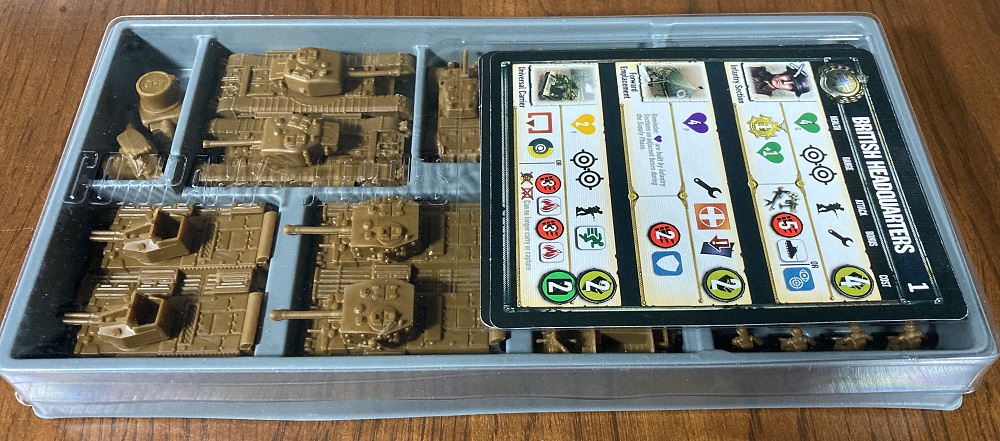
While the game comes with quality components and looks great, the gameplay is just as good. The game designers have done a great job of making the rules very accessible for players new to the genre. The concept of using command points (cp) to maneuver units provides a great representation of leadership and control. While this is not really an issue during the first round or two, as players gain more units on the battlefield, they have to consider how to assign the limited amount of cp. Do you move three units as far as they can go, or advance more units a shorter distance? However, once maneuvering is done, all units within range of enemies may attack. Therefore, maneuvering becomes even more important as players try to maximize the amount of firepower they can bring to bear on the enemy. Even the combat is easy to learn. I like that the attacker just places damage dice on the target, then the defender can roll defense dice depending on the type of attack and if the unit is in a building (the advance rules add both light and heavy cover). The opportunity to purchase new units or upgrades during the supply phase makes capturing and holding control points more important, even if only to deny them to your opponent. Plus the ability to repair or reinforce damaged units adds more consideration as players must decide whether to pull back a unit to increase its health or to push it until it is destroyed and thus giving the enemy a victory point in the process. Plus once you upgrade your units, you want to protect your investments.
For this article, I described the basic rules. They are fun in and of themselves. However, the advanced rules really make Company of Heroes Board Game shine. Don’t let the name advanced rules distress you. They add quite a bit to the game without overloading it with difficulty. The advanced rules are organized along the lines of the basic rules to make it easier to incorporate them. Plus players can choose which rules they want to use. They don’t have to add them all at once. The advanced maneuver rules add the ability to retreat as well as deployment for weapons teams. If they move, they need to spend a cp to deploy before they can attack. This represents taking down and setting up a crew weapon. Plus weapons teams and vehicles have firing arcs based on their facing. For combat, high explosives are variable on how much damage they inflict. They can cause 2 points of damage, 1 point, or none at all depending on the roll of the die. Defense now includes light and heavy cover for terrain other the buildings plus heavy vehicles get extra defense if an attack hits their thicker frontal armor. Some other advanced rules that add to the game include the ability of some infantry units to construct battlefield defenses while buildings can take damage and be destroyed. Machine guns become even more important in the game as they can now pin enemy infantry units during the maneuver phase and pin more than one unit. My opponents have come to fear my machine guns as a result of these advanced rules.

The main way to play Company of Heroes Board Game was described above. However, there are also a few other ways to play. When playing an Annihilation game, the objective is to destroy the enemy’s base. To damage the enemy base, you must attack it with HE or flame damage. In addition, controlling a victory control point does not grant you victory points, but instead lets you damage your enemy’s base by one health for each of these control points you hold. In Purist mode, you only gain victory points for controlling victory point hexes and not for destroying or damaging enemy units. The RTS mode makes the game feel a bit like the video game in that both players spend a single cp simultaneously during the maneuver phase rather than each player spending 3 in alternating turns. Those sand timers that come with the game are for timed play and last 3 minutes. You can use this to limit each player’s turn in the maneuver phase as well as during the purchasing of units and upgrades during the supply phase. These variants provide a lot of different ways to play the game. Another way that I really like to add variety within a game are the commander cards. These let players gain access to specialized abilities and units. For example, the Tiger tank is not on the German building boards. Instead, you would have to pick one of the two commander cards that allow you to call in Tigers. The commander card a player chooses can have a big impact on the tactics they use during a game.
Company of Heroes Board Game really demonstrates the design and testing that went into it. The various factions are balanced while retaining unique characteristics. As I followed the designers during and after their crowdfunding campaign, I was impressed at how they continued to improve the components and rules to make their game even better. The finished product shows their efforts were not in vain. In case you have not yet been able to discern from this review, I am extremely impressed with Company of Heroes Board Game and enjoy playing it. For the many reasons I have already shared, I highly recommend this game to anyone who enjoys a tactical wargame as well as for those to appreciate a well-designed and produced game. Company of Heroes Board Game has also been awarded GeekDad Approved!
For more information and to purchase a copy of the game, visit the Company of Heroes Board Game website!
Click here to see all our tabletop game reviews.
![]() To subscribe to GeekDad’s tabletop gaming coverage, please copy this link and add it to your RSS reader.
To subscribe to GeekDad’s tabletop gaming coverage, please copy this link and add it to your RSS reader.
Disclosure: GeekDad received a copy of this game for review purposes.






